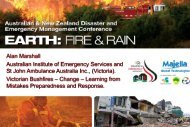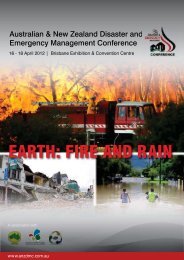Book of Abstracts 2013 - Australian and New Zealand Disaster ...
Book of Abstracts 2013 - Australian and New Zealand Disaster ...
Book of Abstracts 2013 - Australian and New Zealand Disaster ...
Create successful ePaper yourself
Turn your PDF publications into a flip-book with our unique Google optimized e-Paper software.
as a potential lifeline to better underst<strong>and</strong> <strong>and</strong> communicate the social <strong>and</strong> physical complexities <strong>of</strong> natural disasters.<br />
GIS technology literally maps the geographic elements contained within data to provide an analytic vantage point that<br />
no other tool can. By mapping natural disaster triggers, events <strong>and</strong> observations, <strong>and</strong> overlaying this with population<br />
an environmental data, GIS makes it possible to analyse where disaster events have occurred, <strong>and</strong> the impacts caused<br />
by these events. By gaining a deeper underst<strong>and</strong>ing <strong>of</strong> where disasters occur, noticeable patterns begin to emerge,<br />
allowing for predictive modelling to take place. These models can then be used to form the basis for the development <strong>of</strong><br />
new strategies <strong>and</strong> initiatives to help reduce future disaster risks. This presentation will provide emergency<br />
management pr<strong>of</strong>essionals with a detailed insight into how GIS technology can be applied to transform the way we<br />
view natural disasters, <strong>and</strong> ultimately, help to predict <strong>and</strong> prevent catastrophies <strong>of</strong> the future.<br />
Ms Bridget Vercoe<br />
Country Director, World Society for the Protection <strong>of</strong> Animals (WSPA)<br />
Animals Matter in <strong>Disaster</strong>s – the <strong>New</strong> Zeal<strong>and</strong> approach<br />
"Our community expects a well-coordinated <strong>and</strong> efficient response to animal welfare issues during adverse events like<br />
storms. We are vulnerable, too, to international trade repercussions, unless we can demonstrate the highest st<strong>and</strong>ards<br />
<strong>of</strong> animal care. Consumers in our export markets increasingly want to know that products have been farmed ethically,<br />
<strong>and</strong> they will react to poor animal welfare stories. Negative stories in international media can badly damage our<br />
reputation. The more knowledge we have, the better we can coordinate our responses <strong>and</strong> secure the viability <strong>of</strong> both<br />
individual farmers <strong>and</strong> the wider animal-based industries.” (Speech by a former <strong>New</strong> Zeal<strong>and</strong> Agriculture Minister, Hon<br />
Jim Anderton, at NAWEM hosted stakeholder meeting, 2007.) This workshop presentation will briefly explore the<br />
importance <strong>of</strong> good animal emergency management practice, including: the economic ramifications for the <strong>New</strong><br />
Zeal<strong>and</strong> economy, based on findings from a recently released research paper; animal welfare considerations; <strong>and</strong> the<br />
impact on evacuation compliance <strong>and</strong> associated civil defence emergency management procedures. The focus <strong>of</strong> the<br />
presentation will be on the strategies <strong>and</strong> tools that NAWEM is using to facilitate changes to Government policy,<br />
legislative underpinnings to policy, <strong>and</strong> local arrangements to ensure that production <strong>and</strong> companion animal welfare is<br />
adequately managed during an adverse event. This will include discussion on the following recent initiatives <strong>and</strong> policy<br />
changes: NAWEM <strong>and</strong> the benefits <strong>of</strong> having a coordinated <strong>and</strong> collaborative approach to animal emergency<br />
management. The Planning for Companion Animal Welfare in an Emergency. Director’s Guideline for CDEM Groups. A<br />
first for <strong>New</strong> Zeal<strong>and</strong> <strong>and</strong> possibly the world, the guide covers all aspects <strong>of</strong> companion animal welfare emergency<br />
management including planning <strong>and</strong> legal considerations, operational arrangements, animal rescue, <strong>and</strong> the<br />
establishment <strong>and</strong> management <strong>of</strong> a temporary animal shelter. The <strong>New</strong> Zeal<strong>and</strong> Animal Welfare Strategy <strong>and</strong> recent<br />
amendments to <strong>New</strong> Zeal<strong>and</strong>’s Animal Welfare Act1999 . Disability Assist Dog identification – a st<strong>and</strong>ardised<br />
identification tag featuring the civil defence logo, to be worn by all certified disability assist dogs in <strong>New</strong> Zeal<strong>and</strong>. The<br />
tag will assist with recognition <strong>of</strong> these dogs in an emergency, enabling rapid reunification with the owner/h<strong>and</strong>ler if<br />
separated, <strong>and</strong> access to all public centres (evacuation, welfare, recovery etc.) with their owner/h<strong>and</strong>ler.<br />
Dr Mark Wallace<br />
Psychiatrist, Centre for <strong>Disaster</strong> Recovery <strong>and</strong> Trauma<br />
Specialized Psychiatric services for Adult Mental Health Care: Recovery following the<br />
Queensl<strong>and</strong> Natural <strong>Disaster</strong>s 2010 – 2012<br />
Following the Queensl<strong>and</strong> natural disasters in 2010 -2011 State <strong>and</strong> Federal funding was made avaliable to establish<br />
programs to address the psychological needs <strong>of</strong> those experiencing persisting distress. This paper discusses the<br />
patterns <strong>of</strong> distress manifest, clinical teams that were established <strong>and</strong> the treatment modalities used. Specific examples<br />
<strong>of</strong> adult <strong>and</strong> older adult patients that were treated will be used, <strong>and</strong> lessons for future programs will be outlined.






